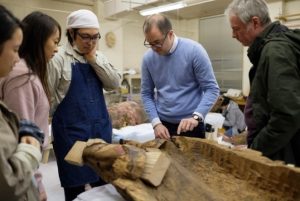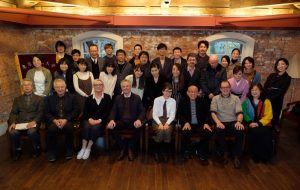In November 2019, a team of specialists from the Art School’s Historic Carving and Conservation Departments and a conservator and wood and urushi expert from the British Museum, took part in a knowledge exchange with Tokyo University of Arts’ (TUA) Sculpture Conservation Research Lab in Tokyo, Japan.
The 14-day trip provided rare opportunities for experts from the UK and Japan to exchange skills and develop links. It followed a previous knowledge exchange, in May 2017, where experts from TUA’s Sculpture Conservation Research Lab visited the Art School in London.
The two-week agenda included workshops, presentations, interviews with craft experts and artists, and a round table discussion, plus a visit to the TUA Lab’s project at Enichi-ji temple and further temples, sites and cultural artefacts in Nara and Kyoto.


Art School tutors and industry experts, Rian Kanduth, specialist in gilding and decorative surfaces, and Gerry Alabone, Head of Frame and Furniture Conservation at the National Trust demonstrating gilding and ‘compo’ to TUA’s MA and PhD students.
Everyone involved found the knowledge exchange trip thoroughly rewarding and incredibly valuable, taking away both theoretical and practical learning points that can inform teaching at the Art School and be employed in professional practice.
The group witnessed how the Japanese concept of ‘intangible cultural properties’, the way that the embodied knowledge of craft practitioners is recognised and valued, informs craft education in Japan. In the face of the Crafts Council reports stating that specialist craft education at University level is at serious risk in the UK, and the Radcliffe Red List including woodcarving and gilding as endangered crafts, this is a timely lesson to learn and supports the Art School’s commitment to champion craft education and craft cultures in the UK.


Alex Owen, conservator and specialist in wood and urushi at the British Museum working on their Japanese collection and Peter Thuring, freelance woodcarver and conservator and Woodcarving Tutor for the Art School’s Historic Carving Department, sharing specialist skills with TUA’s MA and PhD students.
The conservation experts were also impressed with the TUA’s Lab work with 3-D scanning and printing, and are exploring the possibility of introducing this practice at the Art School. In Nara, the Art School and TUA experts considered how the raised urushi ornament on eighth century dry-lacquered statues was applied, and the workshop provided some useful insights.
Furthermore, following Tamiko O’Brien’s interviews and meetings with artists and craft practitioners, contemporary artist Taku Obata, who works with woodcarving and video, was invited to undertake a 6-month research residency at the Art School from May 2019. He will be showing a work in a group show in London at the start of his residency and will exhibit works made during his residency in September 2019 during the MA Show.

The conservation, wood and urushi specialists from Japan and the UK, who took part in the knowledge exchange.
The two-week knowledge exchange visit was an important and valuable opportunity to further build upon a dialogue between the TUA Lab and the Art School’s Historic Carving and Conservation Departments, and plans are in discussion for a return visit from the TUA Lab in 2020. The UK team were tremendously grateful for the great hospitality of their hosts and their willingness to share their knowledge and insights.
Thanks also to the Toshiba International Foundation and the Great Britain Sasakawa Foundation for making the project possible through their generous funding support.




